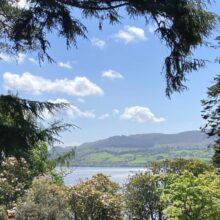Exploring the Gardens of Perthshire, Kinross, and Fife
NTSUSA staff member Emily Fitzsimmons embarked on one of our garden tours this past September. Traveling with NTSUSA members and several of our Trustees, the group traversed across Scotland for six days, exploring its cities, castles, and gardens.
In September, I had the pleasure of joining a lovely group of NTSUSA patrons, friends, and newcomers on our Great Gardens of Perthsire, Kinross, and the Kingdom of Fife tour. This was the second of our three garden-focused trips in 2022 and 2023, with the help of Patrick Scott, co-founder of Discover Scottish Gardens. It was also my first trip to Scotland in many years, and my first opportunity to see some of Trust properties in person.
As I reflect on my travels, it is the peak of autumn here in New England. Vibrant red and golden ochre leaves are falling from the trees and blanketing our cobblestone sidewalks. We had an early taste of autumn on the trip, with surprisingly warm and sunny weather (by Scotland’s standards) that carried just a hint of chill in the air. Although some plants were past their blooming season by early September, we saw plenty of color and just as importantly, texture, which made each and every one of the places we visited a visual delight. On top of it all, our tour was highlighted by warm Scottish welcomes everywhere we went – always including of a hot cup of tea and freshly baked scones.

A Piet Ouddolf design at Cambo

Evening in the reconstructed 1766 Dawson’s Cotton & Wool Shop at Gladstone’s Land
A Night in Edinburgh
Our tour began on Sunday night in Edinburgh, where we were graciously received by members of the Trust’s leadership and property staff at Gladstone’s Land. Located on the Royal Mile just a stone’s throw from Edinburgh Castle, Gladstone’s Land was recently reopened to the public in 2021 after a transformative project to restore and reimagine the property across its four centuries of history. After enjoying some canapés, we were treated to an after-hours tour of the building allowing us to see how it looked in the evening light – a rare treat! As each floor is designed to reflect a different era of life in Old Town, the tour activated our imaginations for the gardens ahead; a mix of historic gardens and wild places in the care of The National Trust for Scotland and privately owned properties that blend tradition with contemporary ideas. Monday morning, we were off to the Kingdom of Fife for our first garden visits – an aptly named region given the natural its bounty of natural riches in the form of flora and fauna. Situated just above Edinburgh, this region is endued with warm summers and mild winters which allows the regions’ gardeners to experiment with all sorts of native and exotic plantings.
No Rain, No Scotland
While overall we were blessed with nearly perfect weather, we did have one quintessentially rainy day! It began with a trip to edge of the Highlands at Blair Castle, the ancestral home of the Dukes of Atholl. We were treated to some classic Scottish scenery en route, traveling on winding roads flanked by mist-shrouded mountains. After warming up with a cup of tea, we headed straight to the estate’s nine-acre walled Hercules Garden, named after the life-size statue overlooking it. The garden has had many lives over the centuries, even being used at a Christmas tree farm during a period of decline, but in the 1990s was meticulously restored to a more historically accurate Georgian jewel.
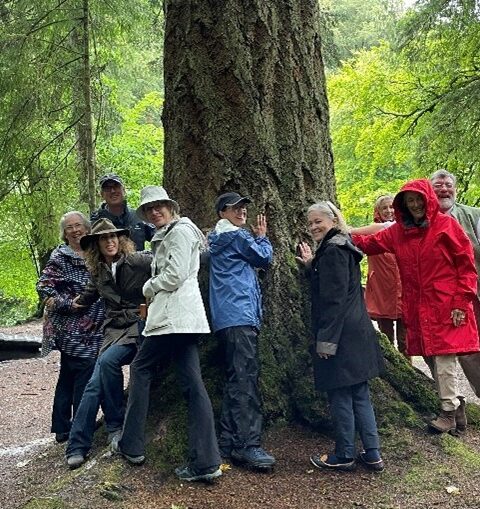
Members of our September 2022 Garden Tour hugging a Douglas fir at The Hermitage
Next on the agenda were two extraordinary sites in the care of the Trust. First was the Hermitage, a magical stretch of Perthshire forest originally designed as a pleasure ground in the 18th century for the Dukes of Atholl. The rain that morning had released the refreshing scent of the Douglas firs that created towering canopies over woodland paths. Many of the trees here were actually brought back to Scotland from the North American Pacific Northwest and grow just as well thanks to the similarly rainy climate. We were joined by Deputy Chair of the Trust, Dr. David Mitchell who guided us along this woodland walk with poetic narration and encouraged us to hug a tree or two on the way. The Hermitage has a sense of the ancient world to it, not only in the giant scale of trees but also in the glacial rocks embedded in the ground and the roaring Linn Falls, where the River Braan crashes into deep, foaming pools below. Perched above the waterfall is the picturesque folly known as Ossian’s Hall, providing hikers with shelter from the elements and a perfect lookout to watch the waterfall.
After a short bus ride, we arrived at Branklyn Garden, a two-acre hillside garden in the rear of an Arts & Crafts style home in Perth, for a tour with Property Manager & Head Gardener, Jim Jermyn. The garden was created in the 1920s by John and Dorothy Renton, keen gardeners who obtained seed collections from famous plant hunters. Dorthy Renton designed her plantings in a way to encourage visitors to get close to them and really look, with layers upon layers of plants including the wonderful Meconopsis for which the garden is famous. At Branklyn, the longer you look, the more rare and interesting plants seems to appear. Another of Branklyn’s highlights is the remarkable rock garden which includes many alpines and provides opportunities to learn about the innovative growing methods that they require. As we were nearly out of the garden, the skies above us opened drenching the group with rain. Luckily, we came prepared with brollies and wellies and embraced it. Much of the United States and Scotland experienced a severe drought this summer so the rain was a welcome sight for plant-lovers. Afterall, as David Mitchell had reminded us earlier at The Hermitage, “no rain means no Scotland.”
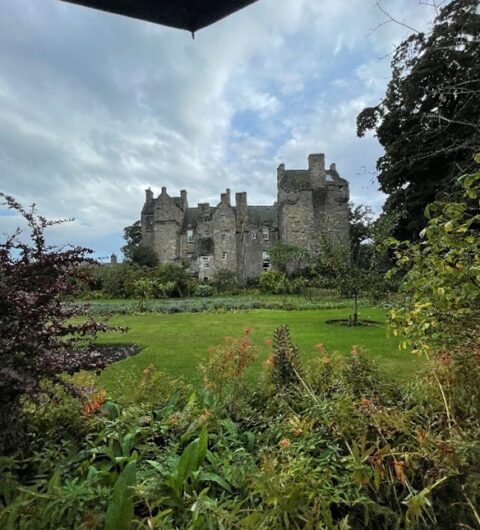
View of Kellie Castle from the Garden
Lorimor Treasures
Before this trip, I knew very little about the Lorimor family of architects, designers, and artists. This would quickly change, as our itinerary included two stops to National Trust for Scotland places with deep connections to the family. The first was Kellie Castle which dates from 1360 and was formerly the seat of the Earls of Kellie. It was a deserted ruin with an abandoned garden when the Lorimer family took it over in the 1890s. The architect Robert Lorimer and his son, the sculptor Hew Lorimer, restored both castle and gardens to what they are today. We were provided a tour of the garden by the Trust’s Head Gardener for Fife, Mark Armour, who shared not only the story of how the Lorimers restored the garden to its former glory, but also how the Trust is using the garden at Kellie Castle today as a resource to learn more about the best growing techniques.
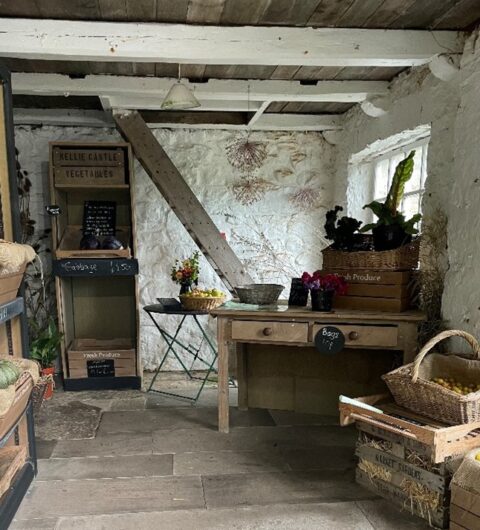
Kellie Castle garden shed
Currently, there is much debate in the gardening world between “dig” and “no-dig” strategies. “Dig” is the traditional way of gardening as we know it, that is, digging up garden beds seasonally when they needed to be replanted. The “no-dig” camp argues that the too much digging disturbs insect life below the soil and suggests that the better way is to add new soil on top of garden beds and plant using that instead. This debate emerged mainly in response to issues caused by commercial farming equipment disrupting soil biodiversity, but on a smaller scale using hand tools, it is not clear which method is best. This is further complicated by the fact that “no-dig” has been popularized in North America where we have a population of earthworms that move and breakdown the soil. In this region of Scotland, however, earthworms have been depleted by an invasive species of New Zealand flatworm, so it might be more beneficial to dig and refresh the soil as the flatworms do not provide that benefit. To get a definitive answer, the garden team at Kellie Castle have set up a “dig” and “no-dig” bed side-by-side and will monitor them over the years to see which one grows better.
Following our in-depth tour with Mark, we were welcomed inside Kellie Castle after-hours to catch a glimpse of the famous Lorimer plaster ceilings. It is a truly whimsical Scottish castle, with fairytale-like features such as turreted staircases and miniature windows. Between the castle itself and the garden, one could easily spend an entire day here getting lost in the details of the architecture and taking in the scents of the garden. As David Mitchell describes it, Kellie Castle is “a timeless fusion of art, science and nature uniquely melded together with an artist’s eye.”

Meeting the butler and head housekeeper at Hill of Tarvit
We also visited the Hill of Tarvit, an estate converted into an Edwardian Mansion in the 1900s by Robert Lorimer for industrialist Frederick Sharp. Although there was once a 17th-century house on the site, it was in such disrepair that Lorimer essentially had to rebuild from the studs up. This provided a unique opportunity to build the house around the furnishings already owned by the Sharp family. For example, an entire paneled oak room was built in the style of the 16th-century to enhance the family’s collection of tapestries that would be installed there. Lorimer also designed and landscaped the gardens and grounds. To the front of the house there are terraced formal lawns with clipped yew hedging on either side of grand stone stairs and yew buttresses along the lower terrace. Today, much of this garden is a work-in-progress to be restored to its 20th century glory. However, even in its current state the expertise of the landscape design is evident, and unique elements capture the imagination – like the garden’s in-tact early 20th century laundry room and hickory golf course. Visitors can even play on the golf course, with period-appropriate dress provided on-site.
Royal Falkland
The grandest site we visited had to be Falkland Palace, once a favorite retreat of Mary Queen of Scots, the Trust now cares for this 16th century palace and its even older garden. The oldest part of the garden was the humble psychic garden, planted with medicinal herbs that were once used as remedies. The main area of the garden sits in walls below the palace. Like some of the other places we visited, it was used for the practical purposes during the world wars, growing potatoes. The garden was recreated in the late 1940s by eminent British garden designer, Percy Cane. Cane was aware of the palace’s history and wanted his design to complement the historic and architectural detail of the building. Today, rows of enormous arborvitae and hedges fill in areas where walls and buildings have vanished. Along the walls, there is a 590-foot long densely planted herbaceous border which was filled with late flowering blooms, just in time for our visit. At the end of the garden through an area of mirroring lily ponds, is the oldest real tennis court in the world. Not only did Mary, Queen of Scots play on the court, but it is still in regular weekly use today!

Members of our September 2022 Garden Tour viewing herbaceous borders at Falkland Palace
Warm Scottish Welcomes
Recently, I have been reading all about the Scottish ideal of “coorie.” The literal meaning of the Scots word is “to stoop, bend, or crouch for protection” or “to nestle” but the word has recently taken on a wider meaning to reflect a lifestyle that sees the keys to happiness as connecting with nature, creating cozy spaces both indoors and outdoors, and welcoming others. I can think of no better word to describe our experiences for the private gardens we had the privilege to visit, most of which are typically open by invitation only.
The first of these was Dowhill (pronounced DOO-hill), a charming private garden created by the current owner Mrs. Pippa Maitland-Dougall and her husband in the 1980s. When they acquired the property, the garden was non-existent, and over the years they tirelessly worked to transform the landscape from fields to a proper country garden, including wild woodland areas with a wonderful variety of shrubs and ornamental trees weaving organically around ponds, a fruit orchard with beekeeping hives on former tennis courts, and grassy lawns near the home abounding with colorful herbaceous borders. Pippa was a convivial guide, leading us around Downhill with the expertise of a ghillie and entertaining us with tales of rabbit hunting and finding a treasure trove of crocus bulbs in the rubbish.
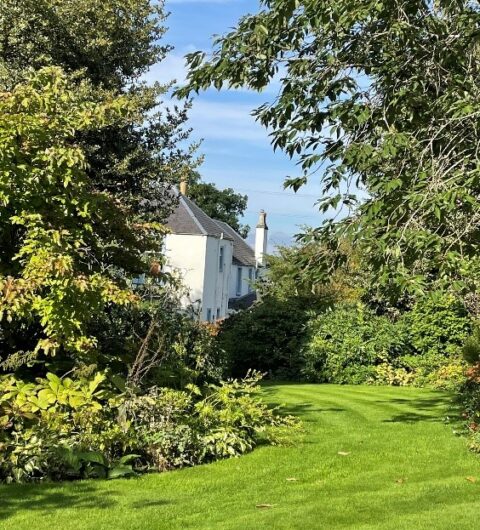
In the arboretum at Pitcurran
After, we stopped for a traditional fish and chips lunch in Kinross before heading on to another spectacular private garden at Pitcurren House. We were greeted by the owner Mrs. Noel-Paton (otherwise known as “P”), who shared the story of how she and her husband turned an unremarkable garden into an arboretum of considerable horticultural interest. It was quite literally an uphill battle – the property steeply slopes with the far end towering above the home. Fruit trees and ornamental trees cascade down the hills highlighted by areas of terraces, borders, and garden beds containing a collection of hydrangea, ericaceous shrubs, peonies, primulas, and Smilicina reacemosa.
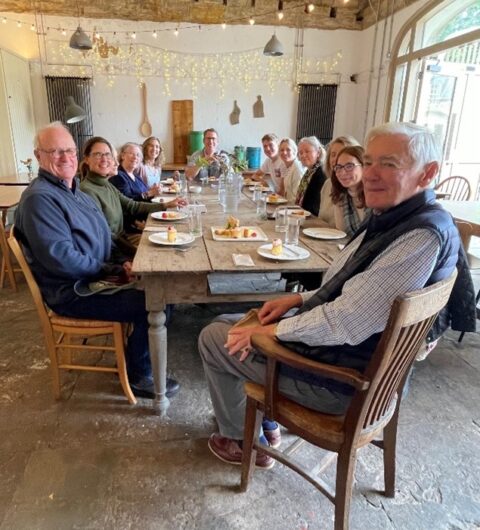
Lunch at Cambo
A few days later we headed in the direction of the North Sea to visit Cambo, just ten miles south of St. Andrews. Cambo has been loved, cared for, and rejuvenated with great skill by Lady Catherine Erskine. The gardens were formally part of Sir and Lady Erskine’s private estate but are now in the care of the Cambo Heritage Trust and open to the public. Before entering the two-and-a-half-acre Victorian walled garden, we walked through an imagining of a North American prairie by the famous Dutch garden designer Piet Oudolf. (This name may be familiar to many Americans, as Oudolf is also known for designing The High Line park in New York City.) Inside the garden walls, a peaceful stream cuts divides the garden in half horizontally, bringing an essence of wildness to an otherwise formal garden. After working up an appetite by visiting the vegetable gardens, we enjoyed an especially delicious lunch at the café consisting of soups, sandwiches, and dessert using fresh ingredients grown on-site.
Our visit to Cambo was followed by a quick jaunt down the coast to Balcaskie, a privately owned estate. The owner Toby Anstruther, whose family has owned the estate since 1698, brought us through traditional terraced gardens that overlook magnificent views to the sea. The planned landscape had a contemporary feel despite the fact that it was designed in the 17th century. Rather than keep an overly manicured look, the orchards on the lowest level have been planted freely with wild grasses sprouting around their roots providing a lovely contrast to the Baroque walls and the ornate Jacobean mansion above. Speaking of the walls, we learned that the walls at Balcaskie had been originally built as heated thermal walls to help the fruit grow. They are hollowed so that hot air lit by fires could move through them with various chimneys lining the top for exhaust purposes, not unlike how ancient Roman baths were heated. Although the heating element of the walls is no longer in use, the fruit trees still flourished at Balcaskie. We were invited to pick Victoria plums directly off the trees and eat them in the garden where they were grown. Somehow, eating the plums amongst the branches where they grew made them taste even more delicious.
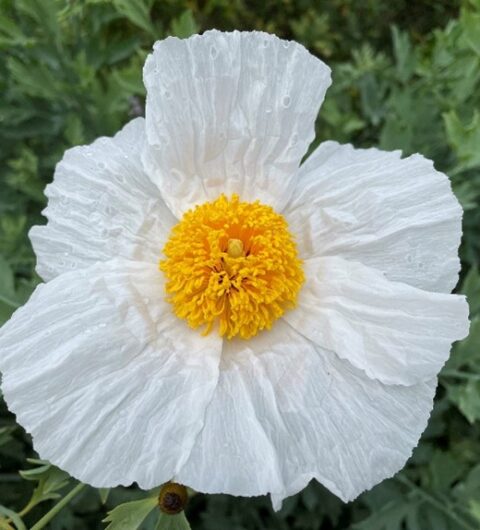
Roneya coulteri, the “fried egg” flower at Balcarres
We also visited the similarly grand home of Lord and Lady Balniel, Balcarres. The drive up to the garden was almost impossibly bucolic with hundreds of sheep dotting rolling hills in every direction. After our ritual stop for tea and scones, Lady Balniel took us through a tour of the grounds which included every type of garden one could imagine, from patterned boxwood hedges with colorful plantings filling the center, to a rose garden and traditional beds filled with unusual dahlias, to wooded areas that grew more wildly. The garden had meaningful personal touches honoring Lord Balniel’s mother who had taken care of it for decades, ruins of ancient stone church overlooking the grounds, and even one of the first photography studios in Scotland tucked inconspicuously next to its greenhouses.
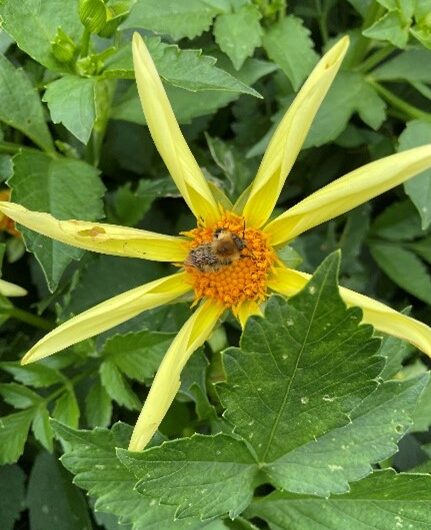
Pollinators in action at Teasses House
Our last private garden was Teasses House, near Cerres, owned by Sir Fraser and Lady Morrison. The family have spent two decades restoring and developing sixty acres at Teasses, consisting of woodland parks and formal gardens. A favorite touch in the walled garden onsite was the bed of geraniums blanketing the ground underneath fruit trees – an unusual touch that gave the feeling of an impressionist painting. Another unique feature was in the woodlands where a Victorian-era dumping ground has been transformed into an oasis, with dramatic rhododendron climbing up walls carved into the earth.
Until Next Time
Our tour ended back in Edinburgh, with a final dinner at the fashionable Kimpton Charlotte Square. We were in the city at an unexpectedly historic moment that night, following the passing of Her Majesty The Queen at Balmoral the previous day. When we arrived back in Edinburgh, the city was buzzing with preparations for the procession that would follow. While sad, it also provided us with an opportunity to reflect on her lifetime and legacy. Even though we were Americans, there were so many memories to share, from watching her coronation in 1953 to her Christmas speech just last year. Between the breathtaking gardens, our welcoming hosts, delicious food, wonderful company, and historic events our tour ended up being even more memorable than expected. Between the immense knowledge shared by the Trust staff and my fellow gardeners, I came home with a head full of ideas for my own garden (currently overgrown with weeds). And I know that I was not the only one looking forward to getting to work!
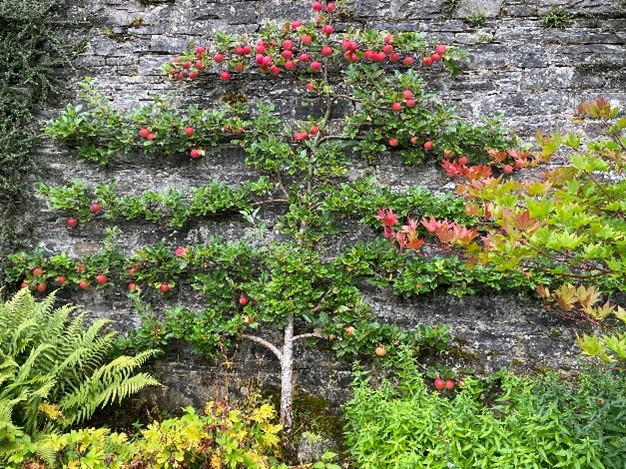
Apple tree at Blair Castle
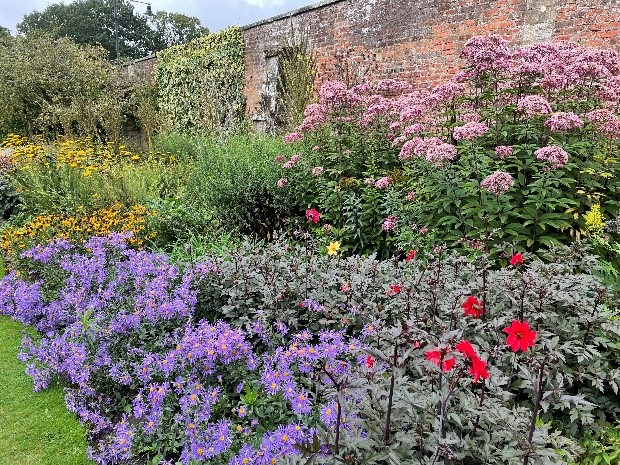
Herbaceous border at Falkland Palace
In September 2023, Paddy Scott will lead another group of NTSUSA friends to the gardens of Aberdeenshire, known for its gorgeous coastline, castles, and the Cairngorms. We will be sharing more information about the next tour soon, but in the meantime, you can register your interest by emailing events@ntsusa.org.

